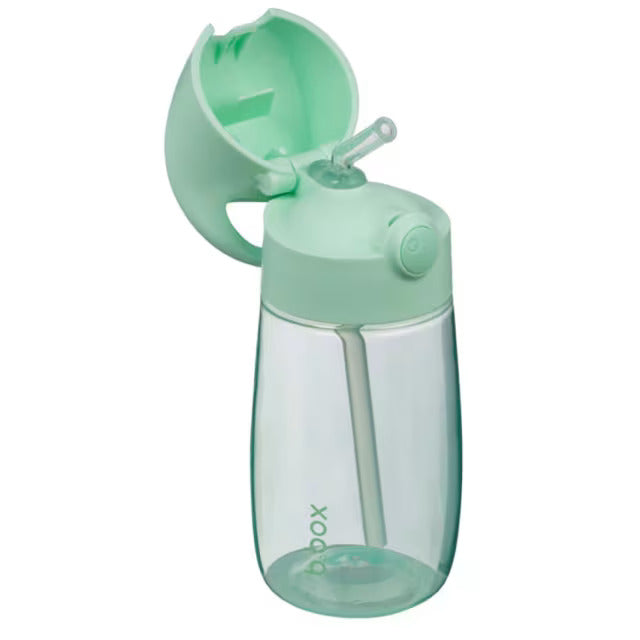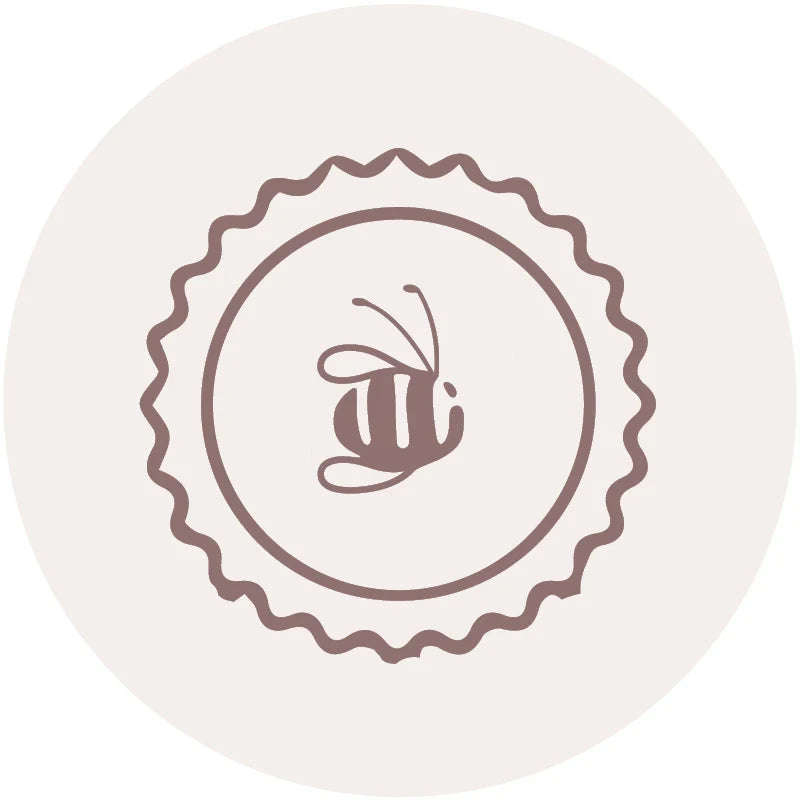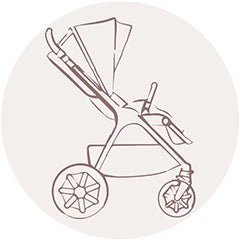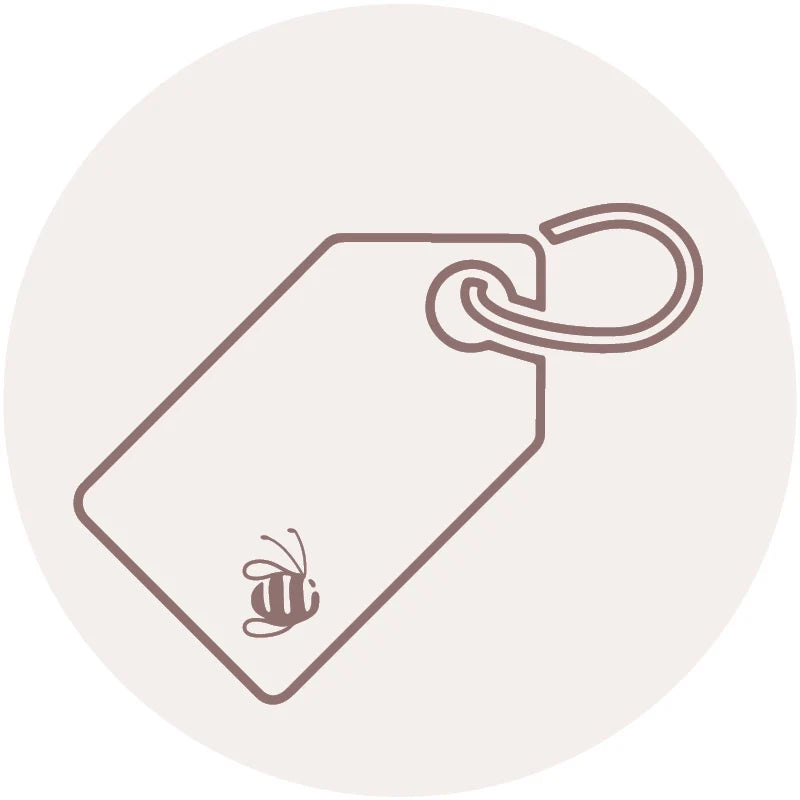380ml Drink Bottle Junior
380ml Drink Bottle Junior
SKU:124290
Clothing Prem to 18 Months
| Size | Age Guide | Weight | Height |
|---|---|---|---|
| Premature | Premature or Small Newborn | Up to 4Kg | Up to 55cm |
| Newborn | 0-3 months | 4-6Kg | Up to 62cm |
| 3 Month | 3-6 months | 6-8Kg | Up to 68cm |
| 6 Month | 6-12 Month | 8-10Kg | Up to 76cm |
| 12 Month | 12-18 Month | 10-12Kg | Up to 84cm |
| 18 Month | 18-24 Month | 12-14Kg | Up to 92cm |
Clothing 2 to 6 Years
| Size | Age Guide | Height | Chest | Waist | Hip |
|---|---|---|---|---|---|
| 2 Year | 2-3 Years | Up to 100 cm | 56 | 51 | 58 |
| 3 Year | 3-4 Years | Up to 105 cm | 58 | 53 | 60 |
| 4 Year | 4-5 Years | Up to 110 cm | 60 | 55 | 62 |
| 5 Year | 5-6 Years | Up to 115 cm | 62 | 57 | 64 |
| 6 Year | 6-7 Years | Up to 120 cm | 64 | 59 | 66 |
Beanie Size Guide
| Size | Head Circumference | Age Guide |
|---|---|---|
| Premature | 31-35 cm | Premature or Small Newborn |
| Newborn | 35-40 cm | Newborn |
| Small | 40-43 cm | 3-6 Months |
| Medium | 43-47 cm | 6-18 Months |
| Large | 47-52 cm | 18-3 Years |
Sunhat Size Guide
| Size | Head Circumference | Age Guide |
|---|---|---|
| Newborn | 37-40 cm | Newborn |
| Small | 40-43 cm | 3-6 Months |
| Medium | 43-46 cm | 6-12 Months |
| Large | 46-49 cm | 12-24 Months |
| Xtra Large | 49-54 cm | 2-4 Years |
Sleep Pods Size Guide
| Size | Weight | Age Guide | Measurement(Back to Hem) |
|---|---|---|---|
| Newborn | 0-6 kgs | 0-3 Months | 60.5 cm |
| Small | 0-8 kgs | 3-6 Months | 66 cm |
Booties Size Guide
| Size | Age Guide |
|---|---|
| Newborn | 0-3 Months |
| Small | 3-6 Months |
| Medium | 6-12 Months |
| Large | 12-18 Months |
Pretty Brave Baby
| Foot Length (mm) | Insole Length (mm) | EU | UK | Age | INT |
|---|---|---|---|---|---|
| 95-104 | 110 | 16/17 | 2 | 0-6m | S |
| 104-114 | 118 | 18 | 3 | 6-12m | M |
| 114-123 | 127 | 19/20 | 4.5 | 12-18m | L |
| 123-137 | 142 | 21/22 | 5.5 | 16-22m | XL |
Pretty Brave 1st Walker
| Foot Length (mm) | Insole Length (mm) | EU | UK | Age |
|---|---|---|---|---|
| 114-120 | 125-128 | 19 | 3 | 1 yr |
| 120-126 | 132-135 | 20 | 3.5 | 1-2 yrs |
| 126-132 | 138.5-141.5 | 21 | 4.5 | 1-2 yrs |
| 132-138 | 145-148.5 | 22 | 5 | 2 yrs |
Crywolf Swim Nappy
| Size | Length (waist to crotch) | Crotch Width (side to side) |
|---|---|---|
| 0-1 yr | 1-2 yrs | |
| 37 | 38 | |
| 14.5 | 15.5 |
Crywolf Rash Suit
| Size | Length (back neck to crotch) | Chest (arm to arm) | Waist (side to side) | Sleeve (neck to cuff) | Neck Opening(diameter) |
|---|---|---|---|---|---|
| 6-12 Months | 1 yr | 2 yrs | 3 yrs | ||
| 40 | 42 | 44 | 46 | ||
| 25 | 26 | 27 | 28 | ||
| 24 | 25 | 26 | 27 | ||
| 30 | 31.5 | 33 | 34.5 | ||
| 13.25 | 13.25 | 13.8 | 14.3 |
Low stock
Couldn't load pickup availability
Overview
Overview
Perfect for growing kids transitioning from a sippy cup to a drink bottle, the Drink Bottle Junior is designed for young children ready to take the next step in independent drinking. It’s easy to carry, simple to open, and offers free-flowing hydration that can handle even the biggest sips. The bottle is leakproof when the lid is securely closed, and the sturdy handle makes it easy to carry and remove from preschool bags. With a capacity of 380mL, it’s the ideal size for toddlers and preschoolers. The modular design allows the Drink Bottle Junior, insulated drink bottle base, and lids to be interchangeable.
Technical Specification
Technical Specification
Delivery and Returns
Delivery and Returns
- Delivery: Free within NZ on orders over $100 (excluding bulky items) or $8 standard shipping
- Returns: Accepted within 14 days of receipt with proof of purchase
- Some items are excluded from returns including sale items, hardware, car seats, prams, monitors and personal items - please click here for the full list.
Share this product
Recently Viewed Products
Related Blogs
Remembering the Precious Times
The days are long but the years go fast! When you’re deep in the baby days, it can feel like time is crawling – but somehow, those tiny toes and gummy smiles slip by in a blink. One minute they’re curled up on your chest, the next they’re racing down the hallway in gumboots. It’s not always easy to stop and take it all in, but future you (and your child) will be so grateful you did. Here are seven lovely ways to capture those fleeting, precious moments. Here are 8 ways to hold onto those little moments ❤️ 1. Keep a journal from bump to babyPregnancy is a season you’ll never forget – and yet, somehow, the details get fuzzy. A journal makes it easy to jot down milestones, memories, and feelings throughout pregnancy and those early newborn weeks. Whether it’s the first kick, a dream you had, or your late-night list of baby names, these snippets will one day become priceless. 2. Save those tiny printsLittle hands and feet don’t stay little for long. A casting kit or impression set is a beautiful way to preserve the size of your baby’s hand or footprint in time. If you’d prefer something bigger, the Petit Artichaut Baby’s First Year Memory Frame is a beautiful alternative – designed to showcase a photo from each month of your baby’s first year alongside a cast or print. It’s a keepsake you’ll treasure forever. 3. Write them a letterIt doesn’t need to be fancy – a few lines on your phone, a scribbled note in a baby book, or an email you save for later. Writing your child letters throughout their early years is a heartfelt way to share what life was like, what you noticed, and how deeply they were loved. 4. Create a home for keepsakesFrom hospital bracelets to first curls, it’s easy to gather a box of “special things” with no real place to put them. The Petit Artichaut Imprint Box offers a charming way to store and display those first small treasures – whether it’s their first lock of hair, their first lost tooth, or something uniquely your own. 5. Capture quotes and milestonesThe things toddlers say are often hilarious, surprisingly insightful, and unforgettable – until they are. A memory jar in the kitchen or a simple notes app on your phone makes it easy to jot them down in the moment. These snippets of daily life will bring the biggest smiles down the track. 6. Frame the moments that matterPhotos on your phone are great, but there’s something special about seeing them every day. The Petit Artichaut Duo Frame is a lovely way to frame meaningful images – maybe their first bath and first birthday, or a newborn photo alongside your ultrasound and a space for a foot or handprint and a clay model of those little hands or feet too. It’s a gentle reminder of just how far you’ve both come. 7. Record it all in a baby record bookFor a classic, timeless way to record milestones, the Your First Years Book or the Peter Rabbit Baby Book are both beautiful choices. These charming books offer space for photos, memories, and all the little details you’ll want to remember, from their first smile to their first steps. With prompts to help you capture key moments, it’s a keepsake that will take you down memory lane for years to come. 8. Record a second a dayApps like 1 Second Every Day make it incredibly easy to film one moment each day and turn it into a time-lapse of your baby’s growth. It’s simple, low-effort, and incredibly powerful – especially when the year wraps up and you get to watch your tiny newborn become a confident little human. There’s no right or wrong way to capture the early years – only what feels right for you and your family. Whether it’s snapping a quick photo, scribbling a sweet moment in a notebook, or tucking away a tiny hospital bracelet, each memory adds to the beautiful story you’re creating. These baby days pass in a blur, but the little things you save along the way will become treasured reminders of just how much love and magic filled those early moments ❤️
Learn moreA mindful approach to family meal times
Written by Kylie Stowe www.nourishedclinic.co.nz In today’s busy modern society, the importance of sitting down together as a family at meal times and eating together and sharing about your day is a lost tradition for many. It is instead often a time that is busy, chaotic, and full of distractions with parents and children eating dinner at different times. There has been a plethora of research conducted around the benefits of family meal times, these benefits are said to include reduced rates of obesity, that adults tend to eat more slowly and often consume less food because they are engaged with other family members and discussion. This leads to less fast-paced mindless eating, chewing food adequately, and time for satiety ques to signal you are full more effectively. Something as simple as slowing down at meal times and chewing food effectively is an incredibly powerful health habit as this allows for the first phase of digestion to happen more efficiently. Cephalic phase digestion, meaning ‘of the head’ occurs at the sight, smell and taste of food and results in the excretion of approximately 20% of the gastric secretions required for digesting foods. Being mindful to slow meal times makes a huge difference in allowing the body adequate time for `these digestive phases to take place, chewing food is an incredibly important part of this process as it not only begins the mechanical breakdown of food but allows foods to be effectively mixed with saliva that is full of enzymes required to break down and digest foods. As a busy mum of four myself, I admit at times that when dinner rolls around at the end of a long day it feels like a chore, and can feel like a ‘job’ that I just want to be over as fast a possible. I have become aware that when I approach meal times in this way I end up feeling more stressed and don’t take the time to cook meals that are as nutritious as I would like, often resulting in me feeding the kids first which almost always leaves them not eating much of their dinner. My kids also don’t wind down as well when we approach meal times in this way and can easily flow on to a more challenging bedtime. In contrast, when we cook and eat together as a family, I usually feel less stressed, my children feel a sense of pride in having helped, and because I have put more thought into that meal time its generally a nutritionally superior meal. I almost always find the kids will eat more of their dinner and be far less fussy when meal times are approached in this way. I also notice my children are more relaxed at bedtime when we have had a relaxing family dinner together also. The research has also indicated that eating together builds stronger family relationships as it allows you all to come together and discuss your day, and feel connected and heard which helps to build a stronger sense of belonging which is thought to build self-esteem. Children learn through an example so role modeling good eating habits and table manners provides a great learning opportunity. As I always say aim for progress, and not perfection when it comes to health, if family meal times are not something that you currently do often in your house aim to implement a day a week and build on that. Don’t let it be a source of stress or guilt but instead a new fun tradition to start as a family. In my next blog, we will take a look at fun ways to get kids in the kitchen to teach them the valuable life skill of cooking. Kylie Stowe www.nourishedclinic.co.nz Veggie-loaded meatballs with salad and kumara wedges Serves 4 Meatballs 400 grams of prime minced beef 1 grated carrot 1C of thinly sliced baby spinach 2 cloves of crushed garlic 1 egg 4 TBSPof grated parmesan 2 TBSPof almond flour 1 tin of Ceres Organics Cherry Tomatoes Handful of freshly chopped thyme Kumara wedges 4 small kumara cut into chunky wedges Drizzle of olive oil Seasoning Side salad 4 cups of salad greens 1C of halves cherry tomatoes 4 TBSP of toasted pumpkin seeds 4 diced gherkins ½ a diced cucumber ½ a diced capsicum Drizzle of balsamic vinaigrette Method Preheat the oven to 180c fan bake Combine and mix through all of the ingredients for the meatballs (besides the tinned tomatoes and thyme) shape into golf ball sized meatballs. Mix the tinned tomatoes and herbs then pop in the fridge while you prepare the kumara wedges. Toss the kumara fries in oil and seasoning. Line a shallow baking dish with baking paper then evenly arrange the kumara wedges and put into the oven. Remove the meatballs from the fridge, lightly brown in a cast iron pan and top with the tomato and herb mixture. Put into the oven. Bake both for approximately 20 minutes depending on your oven. While the kumara and meatballs are baking combine the salad ingredients. I like to serve mine with a dollop of coconut yogurt. Enjoy!
Learn moreThe Play Table Packed with Possibilities
Harness the power of early learning with the Stokke® MuTable that grows and adapts just as quickly as your child’s imagination! Play isn’t just fun – it’s also the foundation of learning. A children’s play table gives little ones the perfect space to explore with both hands and minds. From building the MuTable Play House (which comes complete with dolls and toys) to tackling puzzles or inventing animal adventures with play dough, every activity sparks creativity, problem solving, and growth. The MuTable is designed to grow with your child. It comes with three double sided activity boards, each one offering new adventures and challenges as your little one develops. From quiet solo play to lively group fun, there’s something to spark curiosity at every stage: A wooden cover that flips to become a blackboard for doodles, scribbles, and first masterpieces A reversible landscape board featuring a peaceful nature setting on one side and a bustling city scene on the other A bricks board with surfaces for both small and large blocks, giving building projects endless possibilities The MuTable chairs are perfectly sized for little ones to sit comfortably while they draw, build, and create. Cleverly designed to grow with your child, the seat height can be adjusted as they get bigger. When it’s time for a change, simply remove the backrest and the chair transforms into a sturdy stool that can hold up to 100kg. Why a child’s play table is a game changer A fun zone for kidsA child-sized play table and chair set creates a safe, comfortable space just for them. It encourages proper posture while giving little ones their very own place to play, build, and create. Nurtures creativityFrom drawing and painting to building towers or sculpting playdough, a play table becomes the stage for endless adventures. With the MuTable’s colourful, tactile boards, your child can dive into imaginative worlds every day... saving the city, exploring nature, or inventing their own stories. Encourages independenceEasy access to their own table and chairs means children can jump into play whenever they choose. This sense of ownership helps build problem-solving skills, self-sufficiency, and confidence. Brings kids togetherA play table is also a hub for teamwork. Kids can play side by side, sharing space while still enjoying their own chair. This is perfect for collaboration, cooperation, and making memories. Made to lastCrafted from premium natural wood, the MuTable and chairs are built for years of use, backed by a 3-year warranty. Softly curved edges ensure safety, while the award-winning design blends seamlessly with any home. Grows with your childDesigned to adapt as your little one gets older, both the table and chairs come with leg extensions to raise the height as needed. The clever design means the MuTable keeps up with every stage of childhood.
Learn moreHealthy Eating - Kids in the kitchen
Kids in the kitchen – building a foundation of health I am hugely passionate about building a strong foundation of health for children, so that they don’t spend a large chunk of their lives attempting to undo bad habits or with chronic health conditions. One really impactful way to do this is to teach them how to cook nutritious home cooked meals from scratch. This builds confidence in the kitchen and is an incredibly valuable life skill to have so that when they eventually leave home they know how to cook and won’t need to rely on takeaways and nutritionally poor foods. It is also a really nice way to mindfully spend time with your children in a way that is really fun for the whole family. There is continually more emphasis being placed on the importance of teaching children to eat healthy nutritious foods, due to the prevalence of childhood obesity, the behavior and learning implications of nutritional deficiencies and obesity related health issues. Did you know that one in nine of our New Zealand children are classified as being obese? Our childhood obesity rates really highlight the importance of education for children about nutrition and how to cook homemade meals. As a parent it is often a battle to get children to eat healthy foods, they are inundated with advertising and clever marketing that promotes and encourages less than ideal foods, such as sugar laden cereals and juices with their favorite cartoon characters, or sports heroes on the packaging. It is everywhere you look, and in our busy modern society takeaways have become the norm and not just a treat anymore. As a busy mum of four myself I have felt plenty of mum guilt at times for looking for easy meal options that aren’t as nutritious as I would like out of time constraints and food preferences of my children. Thankfully now I have a far less idealistic view on nutrition for my family and realise that there is no such thing as being the perfect Mum and that it is perfectly healthy for families to also have treat foods, and to enjoy them occasionally without guilt while ensuring majority of the time they are eating well. Teaching my own children, and others at a local primary school how to cook different meals has been a really rewarding experience. Children love to learn through ‘doing’ and are far more receptive to trying new foods when they are involved in the cooking process. One of my favorite things to do it to write a list of their favorite foods, this is very predictable with kids and generally consists of pizza, burgers and fries then discuss how we can make these foods at home and what we can do to add in extra nutrients. For example, Pita pizzas with different herbs, vegetables and homemade pizza sauce, burger patties with mince and grated vegetables, hand cut and oven baked kumara fries etc. You can make this really fun by making a recipe together, formulating a shopping list and letting them help find the ingredients, my three-year-old loves this! There are so many great cookbooks and websites that offer great ideas and tips these days. Some of my favorites include. A great resource for all things vegetables including nutritional information, preparation tips, and educational resources https://www.vegetables.co.nz/ A great resource of recipes & children’s goal setting charts for healthy eating https://www.healthykids.org.nz/ A personal favourite for lots of delicious kid friendly nutritious recipes would have to be Nadia Lim’s Kid section on her website https://nadialim.com/?sfid=974&_sft_meals_courses=kid-friendly For my older boys one activity that they really loved from around the age of five was picking a country, then looking for one of their traditional dishes and cooking it. The most loved one that was often repeated was Mexican fiesta night with tacos, pepitas and guacamole. This is a really fun way to get children in the kitchen and trying new foods. I have also found meal subscriptions like HelloFresh great for the older kids as everything they need including a simple recipe card is all included. They get really excited when they are making dinner themselves and it creates a huge feeling of accomplishment in them and also as a mum! Other skills that are strengthened when it comes to cooking with children include basic maths in younger children through counting and measuring. This also builds communication and language skills by discussing ingredients and recipes. Pre-schoolers are well known for being fussy eaters, encouraging them to explore different foods and textures by involving them in meal time preparation can really help to broaden their palate. You can also talk about how healthy foods help us to grow and the differences between different foods such fruits and vegetables, or for older children carbohydrates, protein and fats. This can also be a great time to explore mindful eating by engaging the difference senses during food preparation. Exploring the different appearances, textures, smells, tastes and sounds of food, exploring this is a wonderful way to be engaged for children and parents Most importantly have fun with it, you’re teaching your children an incredibly important life skill that will benefit them for years to come, instilling independence and not to mention eventually some time out from cooking yourself – win,win! Kylie Stowe @melawholefoods Pita Pizza Serves 4 This is a firm favorite amongst my children and was also one of the most loved in my kids cooking & nutrition classes. It is really fun to head to your local farmers market on the weekend and let the kids pick some different ingredients to try, it is also a great way to learn about the different seasons when different produce is available. The recipe below is for a basic pita pizza as a guide but have fun with this and let the kids build their own and try new things. Ingredients - 4 wholemeal pita - 4 tbsp of tomato paste - 2 handfuls of basil leaves - 16 cherry tomatoes - 1 sliced smoked chicken breast - 1 sliced capsicum - 1c of mozzarella cheese Method 1. Preheat the oven to 180c fan bake, and line a baking tray with baking paper. 2. Place the pita bread on the tray, top with tomato paste, then basil. Equally arrange the other ingredients on the pita. Top with cheese. 3. Bake for 10 minutes, or until golden. Enjoy! These are really nice served with salad.
Learn more














